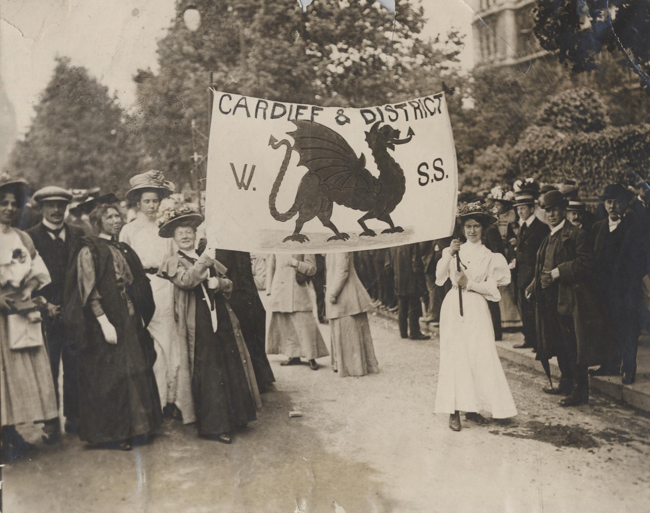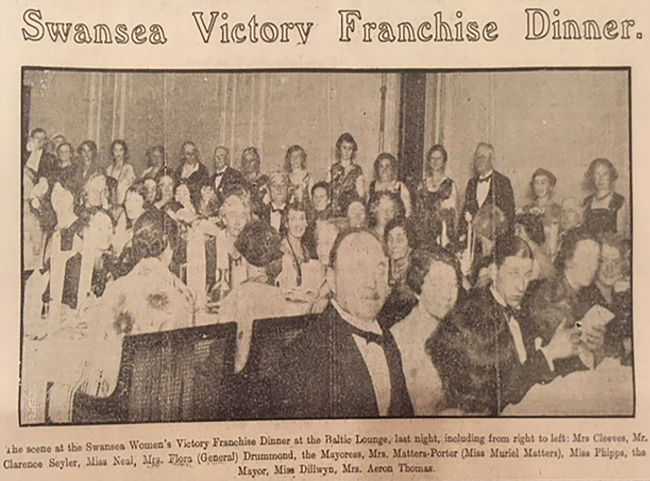The origins of the Women’s Suffrage Movement in Wales
An organised women's suffrage movement operated continuously in Britain for more than sixty years, with partial enfranchisement won in 1918 and equal voting rights with men finally achieved ten years later.
This online gallery aims to provide a snapshot of Wales's part in this lengthy and multifaceted campaign, the photographs, images and artefacts seeking to illustrate some of its principal elements.
In the years prior to the outbreak of the First World War in August 1914, three main organisations, spearheading a host of propaganda and pressure strategies, elevated ‘Votes for Women’ into a major issue in British politics.

Poster of first women’s suffrage meeting to be held in Wales, Merthyr Tydfil. 1870

Emmeline Pankhurst speaking in Haverfordwest. 11.07.1908

Women's Sunday, the WSPU’s first major demonstration, Hyde Park. 21.06.1908
© Museum of London
The Women’s Suffrage Movement in Wales in the early 1900s
Members of Emmeline Pankhurst’s Women’s Social and Political Union (WSPU, founded in 1903) – the notorious ‘suffragettes’ – pursued a militant strategy, involving escalating attacks on public and private property, which often brought the arrest and imprisonment of activists.
Their policy of heckling politicians (and most especially in Wales, David Lloyd George) led to disruption and disorder at the National Eisteddfod on two occasions and to some of the most serious physical attacks upon campaigners.

Wales’s first suffragette prisoner, Mary Keating Hill (centre) of Mountain Ash, leaving Holloway prison.01.1907
© Llyfrgelloedd Caerdydd - Cardiff Libraries

National Eisteddfod, Albert Hall. Suffragette being turned away after interrupting Mr Asquith. 06.1909
©Media Wales
The Women’s Freedom League (WFL) broke away from the WSPU in 1907 and established a distinct identity of ‘militant but non-violent’ civil resistance, such as the refusal to pay taxes and boycott of the 1911 census.
 Cardiff WFL branch members leave Cardiff to interview Mr Asquith. February 1909.
Cardiff WFL branch members leave Cardiff to interview Mr Asquith. February 1909.
©Media Wales

Women’s Freedom League, Caernarfon Office.08.02.1910
©Gwasanaeth Archifau Gwynedd - Gwynedd Archive Service
By far the largest number of the campaigners – ‘suffragists’ – supported the non-militant and strictly law-abiding National Union of Women’s Suffrage Societies (NUWSS), which was formed from existing organisations in 1897 and led by Millicent Fawcett.


Suffragette Grand March, London.13.06.1908
©Media Wales

Suffragettes in Castle Square, Caernarfon.c.1913
©Gwasanaeth Archifau Gwynedd - Gwynedd Archive Service
All three societies, and many other smaller organisations including the (Forward) Cymric Suffrage Union, undertook an enormous amount of lobbying and propaganda work, holding thousands of public meetings in all corners of the country, and disseminating their newspapers and other literature (including some in the Welsh language).
It should not be forgotten too that powerful and determined opposition to women’s suffrage –from the ‘Antis’ – was evident as the campaign escalated.

Anti-suffrage voodoo doll sent anonymously to a woman in west Wales. Early 1900
© Amgueddfa Cymru – National Museum Wales
The Women’s Suffrage Movement in Wales in the 1920s
With the outbreak of the First World War in August 1914 the women’s suffrage campaign was side-lined though far from eclipsed as most suffragists and suffragettes turned their attention to supporting the war effort.
While Emmeline Pankhurst and the leadership of the WSPU replaced militancy with militarism, splinter groups and other organisations played an important role in ‘keeping the suffrage flag flying’ and ten months before the end of the conflict (in February 1918) women were granted the parliamentary vote for the first time.

Punch Magazine.23.01.1918

Lady Rhondda and Emily Pankhurst at Equal Rights Demonstration, Illustrated Sunday Herald. 04.07.1926
 Swansea Victory Franchise Dinner, Cambria Daily Leader. 20.10.1928
Swansea Victory Franchise Dinner, Cambria Daily Leader. 20.10.1928
It was however a partial victory only, for the legislation confined the vote to women over thirty who met certain property qualifications (while all men over twenty-one, or even nineteen if they had served in the armed forces) became eligible. The struggle thus continued for another decade until equal enfranchisement on the same terms as men – at the age 21 and without any property qualifications – was achieved in July 1928.
Ryland Wallace (Author of The Women’s Suffrage Movement in Wales, 1866-1928)





